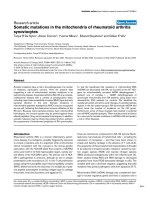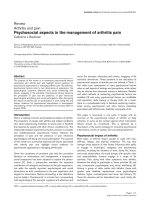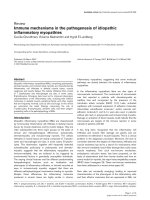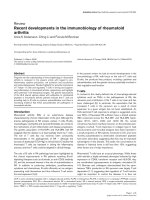Báo cáo y học: "Rotating antibiotics in the intensive care unit: feasible, apparently beneficial, but questions remain" docx
Bạn đang xem bản rút gọn của tài liệu. Xem và tải ngay bản đầy đủ của tài liệu tại đây (37.05 KB, 3 trang )
MRSA = methicillin-resistant Staphylococcus aureus.
Available online />Raymond et al. from the University of Virginia, USA published
work into rotating empirical antibiotics in an intensive care
unit in June 2001 [1]. This was the first time that a quarterly
rotation of empirical antibiotics used for 1 year was
compared with the previous year of non-protocol-driven use
in critically ill patients. The research showed that rotation was
associated with a significant reduction in infection episodes
caused by Gram-negative, antibiotic-resistant organisms.
The paper also showed that rotating antibiotics resulted in a
lower incidence of Gram-positive coccal infections, less
methicillin-resistant Staphylococcus aureus (MRSA) and
gentamicin-resistant enterococci infections, and a clear
reduction in mortality associated with infection. In fact,
antibiotic rotation was an independent predictor of survival.
The Raymond et al. paper was welcomed news because we
are clearly facing an antibiotic crisis [2,3]. Bacterial resistance
is progressing faster than the number of new antibiotics
available to the clinician, resulting in higher costs and poorer
outcomes [4]. To meet this challenge, new strategies that
optimise the use of available antimicrobials are urgently
needed. Rotating antibiotics is one possible approach.
How rotating antibiotics works
While the basic principle of rotating antibiotics is simple,
behind it lie a number of conceptual and practical issues that
are much more complex. A first antibiotic regimen is chosen
for a group of patients during a specific period of time, then a
second regimen is selected for another period, and then
perhaps a third, and even a fourth, regimen may follow [5].
The same sequence of antibiotic regimen is then repeated.
The basic idea is that a bacterium that becomes resistant to
the first regimen would remain susceptible to the second
regimen. If it is resistant to the second regimen, the third
regimen should cope with the resistance, and so on.
Acquiring successive mechanisms of resistance can have
metabolic consequences for the bacterium. For instance, if
the resistance comes from a plasmid, the bacterium may
require more energy during bacterial multiplication or for
producing large amounts of beta-lactamases. It may
alternatively lead to variations in the bacterium’s ability to take
up nutrients. The multiplication of resistance mechanisms in
the same bacterial cell line should hence be detrimental to its
optimal propagation, allowing sensitive bacteria (with
supposedly better fitness) to take over. The expected
consequence would be a decline in resistance and easier
management of infected patients.
Threats to rotation
Bacteria possess mechanisms that allow them to become
resistant to several structurally unrelated antibiotics at once.
Mobile genetic elements that encode for numerous
Commentary
Rotating antibiotics in the intensive care unit: feasible,
apparently beneficial, but questions remain
Jean-Claude Pechère
Professor, Department of Genetics and Microbiology, University of Geneva, Switzerland
Correspondence: Jean-Claude Pechère,
Published online: 11 January 2002
Critical Care 2002, 6:9-10
© 2002 BioMed Central Ltd (Print ISSN 1364-8535; Online ISSN 1466-609X)
Abstract
Rotating antibiotics in the intensive care unit may result in less infections caused by resistant
organisms and in even less mortality. The selection of super-resistant organisms associated with the
rotation strategy cannot be excluded, however, and many practical issues will have to be addressed
before antibiotic rotation can be routinely recommended.
Keywords antibiotic, resistance, rotation policy
Critical Care February 2002 Vol 6 No 1 Pechère
resistance mechanisms can become incorporated into the
stable genetic structures of bacteria. These could jeopardise
the rotation strategy [6]. Besides the well-known plasmids,
bacteriophages, and transposons, the more recently
described integrons can capture multiple gene cassettes,
express them, and then integrate them into the chromosome
[7]. The genes found in integrons often encode antibiotic
resistance, including proteins such as efflux pumps, acetyl-
transferases, dihydro-folate reductases, and beta-lactamases
[8]. Furthermore, co-selection of resistance determinants can
be achieved by numerous other molecular mechanisms of
resistance, representing additional threats to the rotation
strategy. For instance, the combination of quinolone and
methicillin resistance is often observed in S. aureus [9].
Multidrug active efflux systems can pump out an astonishing
number of unrelated antibiotics, any of these substrates
acting as a potential trigger [10]. Some efflux systems are
co-regulated with outer membrane permeability. For example,
activation of the MexE-MexF-OprN multidrug efflux system
generates an OprD (the carbapenem porin) deficiency, so
that ciprofloxacin, for instance, can select resistance to
carbapenems in the absence of carbapenem exposure [11].
Extended-spectrum cephalosporin use is associated with
infection and colonisation with vancomycin-resistant
enterococci [12]. Klebsiella pneumoniae strains producing
extended-spectrum beta-lactamases often harbour plasmids
that encode resistance to other antibiotics [13] and that
cross-resist to quinolones by mechanisms that are currently
unclear [14]. Moreover, the metabolic consequences of
some multiple resistances are questionable considering the
remarkable stability of mecA in the MRSA, vancomycin-
resistant determinants in the enterococci, or integrons in
nature, even in the absence of antibiotic pressure.
Practical issues are also complex [15]. A general consensus
has to be obtained between hospital administration, health
carers, and pharmacists: all prescribers have to follow the
guidelines; the different regimens used in the rotation must
be chosen in the light of recent scientific knowledge; the
duration of each cycle must be between the ‘too short’, the
‘difficult to implement’, and the ‘too long’, allowing the
selection of resistance during therapy despite the rotation
policy; and, above all, optimal infection control measures
have to be ensured.
Conclusions
The few published studies that address the antibiotic rotation
strategy gave positive signals. For example, an influence of
the aminoglycoside in use on aminoglycoside resistance
patterns was reported [15,16], and a diminution in the rates
of ventilated associated pneumonia [17], including those
caused by MRSA [18], was observed. A decline in faecal
vancomycin-resistant enterococci colonisation was also
reported [19]. None of these studies, however, investigated
an actual rotation policy including a sufficient number of
cycles; that is why the paper by Raymond et al. was so
welcomed.
Antibiotic rotation is feasible and apparently beneficial, but
many questions remain unanswered. All the studies published,
including that of Raymond et al., used historical controls
(before versus after studies), which is inappropriate
considering the variable nature of bacterial epidemiology. The
risk of selecting ‘super-resistant bugs’ during the rotations has
not been specifically addressed. The time has come for large,
co-operative international studies on these important issues.
Competing interests
None declared.
References
1. Raymond DP, Pelletier SJ, Crabtree TD, Gleason TG, Hamm LL,
Pruett TL, Sawyer RG: Impact of a rotating empiric antibiotic
schedule on infectious mortality in an intensive care unit. Crit
Care Med 2001, 29:1101-1108.
2. Cohen MT: Epidemiology of drug resistance: implications for a
post antimicrobial era. Science 1992, 257:585-590.
3. American Society for Microbiology: Report of the ASM Task
Force on Antibiotic Resistance. Antimicrob Agents Chemother
1995, 39(suppl 5):1-23.
4. Gleason TG, Crabtree TD, Pelletier SJ, Raymond DP, Karchmer
TB, Pruett TL, Sawyer RG: Prediction of poorer prognosis by
infection with antibiotic resistant gram-positive cocci than by
infection with antibiotic-sensitive strains. Arch Surg 1999,
134:1033-1040.
5. McGowen JE Jr: Minimizing antimicrobial resistance in hospi-
tal bacteria: can switching or cycling drugs help? Infect
Control 1986, 7:573-576.
6. John JF, Rice LB: The microbial genetics of antibiotic cycling.
Infect Control Hosp Epidemiol 2000, 21(suppl):S22-S31.
7. Bennett PM: Integrons and gene cassettes: a genetic con-
struction kit for bacteria. J Antimicrob Chemother 1999, 43:1-4.
8. Hall RM, Collis CM: Antibiotic resistance in gram-negative bac-
teria: the role of cassettes and integrons. Drug Resist Updates
1999; 1:109-119.
9. Tanaka M, Zhang YX, Ishida H, Akasaka T, Sato K, Hayakawa I:
Mechanisms of 4-quinolone resistance in quinolone-resistant
and methicillin-resistant Staphylococcus aureus isolates from
Japan and China. J Med Microbiol 1995, 42:214-219.
10. Köhler T, Pechère JC, Plésiat P: Bacterial antibiotic efflux
systems of medical importance. Cell Mol Life Sci 1999, 56:
771-778.
11. Köhler T, Epp SF, Curty LK, Pechère JC: Characterization of
MexT, the regulator of the MexE-MexF-OpN multidrug efflux
system of Pseudomonas aeruginosa. J Bacteriol 1999, 181:
6300-6305.
12. Moreno F, Grota P, Crisp C, Magnon K, Melcher GP, Jorgensen
JH, Patterson JE: Clinical and molecular epidemiology of van-
comycin-resistant Enterococcus faecium during its emer-
gence in a city in Southern Texas. Clin Infect Dis 1995, 21:
1234-1237.
13. Jacoby GA, Medeiros AA: More extended-spectrum beta-lacta-
mases. Antimicrob Agents Chemother 1991, 35:1697-1704.
14. Schiappa DA, Hayden MK, Matushek MG, Hashemi FN, Sullivan J,
Smith KY, Miyashiro D, Quinn JP, Weinstein RA, Trenholme GM:
Ceftazidime resistant Klebsiella pneumoniae and Escherichia
coli bloodstream infection: a case–control and molecular epi-
demiologic investigation. J Infect Dis 1996, 174:529-536.
15. Gerding DN, Larson TA, Hughes RA, Weiler M, Shanholtzer C,
Peterson LR: Aminoglycoside resistance and aminoglycoside
usage: ten years of experience in one hospital. Antimicrob
Agents Chemother 1991, 35:1284-1290.
16. King JW, White MC, Todd JR, Conrad SA: Alterations in the
microbial flora and in the incidence of bacteremia at a univer-
sity hospital after adoption of amikacin as the sole formulary
aminoglycoside. Clin Infect Dis 1992, 14:908-915.
17. Kollef MH, Vlasnik J, Sharpless L, Pasque C, Murphy D, Fraser V:
Scheduled change of antibiotic classes. A strategy to
decrease the incidence of ventilator-associated pneumonia.
Am J Resp Crit Care Med 1997, 156:1040-1048.
18. Gruson D, Hilbert G, Vargas F, Valentino R, Bebear C, Allery A,
Bebear C, Gbikpi-Benissan G, Cardinaud JP: Rotation and
restricted use of antibiotics in a medical intensive care unit.
Impact on the incidence of ventilator-associated pneumonia
caused by antibiotic resistant Gram-negative bacteria. Am J
Resp Crit Care Med 2000, 162:837-843.
19. Quale J, Landman D, Saurina G, Atwood E, DiTore V, Patel K:
Manipulation of a hospital antimicrobials formulary to control
an outbreak of vancomycin resistant enterococci. Clin Infect
Dis 1996, 23:1020-1025.
Available online />









